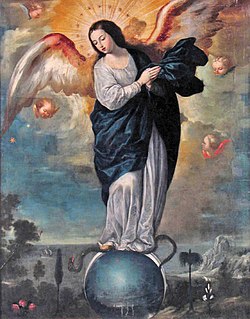 W
WSpanish Baroque Painting refers to the style of painting which developed in Spain throughout the 17th century and the first half of the 18th century. The style appeared in early 17th century paintings, and arose in response to Mannerist distortions and idealisation of beauty in excess, appearing in early 17th century paintings. Its main objective was, above all, to allow the viewer to easily understand the scenes depicted in the works through the use of realism, while also meeting the Catholic Church's demands for 'decorum' during the Counter-Reformation.
 W
WThe Spanish Golden Age is a period of flourishing in arts and literature in Spain, coinciding with the political rise of the Spanish Empire under the Catholic Monarchs of Spain and the Spanish Habsburgs. The greatest patron of Spanish art and culture during this period was King Philip II (1556-1598), whose royal palace, El Escorial, invited the attention of some of Europe's greatest architects and painters such as El Greco, who infused Spanish art with foreign styles and helped create a uniquely Spanish style of painting.
 W
WSpanish Baroque is a strand of Baroque architecture that evolved in Spain, its provinces, and former colonies.
 W
WThe term bodega in Spanish can mean "pantry", "tavern", or "wine cellar". The derivative term bodegón is an augmentative that refers to a large bodega, usually in a derogatory fashion. In Spanish art, a bodegón is a still life painting depicting pantry items, such as victuals, game, and drink, often arranged on a simple stone slab, and also a painting with one or more figures, but with significant still life elements, typically set in a kitchen or tavern. It also refers to low-life or everyday objects, which can be painted with flowers, fruits, or other objects to display the painter's mastery.
 W
WThe Cusco School or Cuzco School, was a Roman Catholic artistic tradition based in Cusco, Peru during the Colonial period, in the 16th, 17th and 18th centuries. It was not limited to Cusco only, but spread to other cities in the Andes, as well as to present day Ecuador and Bolivia.
 W
WLa vida y hechos de Estebanillo González, hombre de buen humor, Life and facts of Estebanillo González, man of good humour, is a Spanish picaresque novel, written as a genuine autobiography of a rogue, but for some scholars, it is a work of fiction. Against the background of the Thirty Years War, the main character writes about his life being a servant of distinguished masters, in a personal narrative all Europe around as a soldier, messenger, etc., witnessing important historic events, such as the Huguenot rebellions while placed in France as the servant to an undercover spy. He serves as part of the company under the command of Cardinal-Infante Ferdinand of Spain ravaging the French provinces of Champagne, Burgundy and Picardy, and even threatening Paris in 1636. It is one of the last great achievements of Spanish Baroque literature during the seventeenth century.
 W
WNew Spanish Baroque, also known as Mexican Baroque, refers to Baroque art in the Viceroyalty of New Spain. During this period, artists of New Spain experimented with expressive, contrasting, and realistic creative approaches, making art that became highly popular in New Spanish society.
 W
WThe Quito School is a Latin American artistic tradition that constitutes essentially the whole of the professional artistic output developed in the territory of the Royal Audience of Quito – from Pasto and Popayán in the north to Piura and Cajamarca in the south – during the Spanish colonial period (1542–1824). It is especially associated with the 17th and 18th centuries and was almost exclusively focused on the religious art of the Catholic Church in the country. Characterized by a mastery of the realistic and by the degree to which indigenous beliefs and artistic traditions are evident, these productions were among of the most important activities in the economy of the Royal Audience of Quito. Such was the prestige of the movement even in Europe that it was said that King Carlos III of Spain (1716–1788), referring to one of its sculptors in particular, opined: "I am not concerned that Italy has Michelangelo; in my colonies of America I have the master Caspicara".
 W
WThe sarabande is a dance in triple metre.
 W
WThe Sopó Archangels is a famous collection of oil paintings from the Colombian colonial period which is located in the Church of the Divine Savior in the Colombian municipality of Sopó.
 W
WTenebrism, from Italian tenebroso, also occasionally called dramatic illumination, is a style of painting using especially pronounced chiaroscuro, where there are violent contrasts of light and dark, and where darkness becomes a dominating feature of the image. The technique was developed to add drama to an image through a spotlight effect, and is common in Baroque paintings. Tenebrism is used only to obtain a dramatic impact while chiaroscuro is a broader term, also covering the use of less extreme contrasts of light to enhance the illusion of three-dimensionality.
 W
WDiego Rodríguez de Silva y Velázquez was a Spanish painter, the leading artist in the court of King Philip IV and of the Spanish Golden Age. He was an individualistic artist of the contemporary Baroque period. He began to paint in a precise tenebrist style, later developing a freer manner characterized by bold brushwork. In addition to numerous renditions of scenes of historical and cultural significance, he painted scores of portraits of the Spanish royal family and commoners, culminating in his masterpiece Las Meninas (1656).